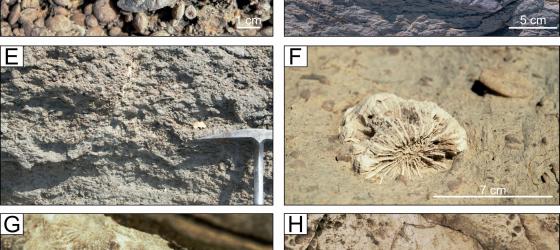The paleontological site
The rocks that emerge along the entire Capo Mortola promontory, widely used for the construction of almost all the paths of the Hanbury Botanical Gardens (GBH), have a very distant origin in time and still show the signs of many events that have shaped them as they appear today. These rocks are visible as clearly inclined layers that dip towards the east; it is a succession of sedimentary rocks that become younger as you move upwards (therefore moving from the Miruna beach towards the mouth of Rio Sorba). This same succession of layers is found, specularly, to form the eastern part of Capo Mortola (where La Nave is located), showing us that overall we are observing an important geological structure formed by the folding of the rocks.
The oldest rocks we find are of Cretaceous age (about 80 million years ago) and today they are found outcropping along part of the bay immediately west of the promontory (Baia della Miruna): they were formed from muddy sediments deposited in a very deep sea and within them are found the remains of many unicellular planktonic organisms belonging to the group of foraminifera and called globotruncanids.
The next rocks are of Eocene age (about 40 million years ago) and are those that make up the majority of the promontory. These rocks are very rich in molluscs remains (including oysters, clams, gastropods), solitary corals and many large foraminifera of the genus Nummulites. This fossil association indicates that the sediment was deposited in a shallow sea environment, with relatively warm and transparent waters; probably, a short distance away, a river network carried fine particles to the sea at fairly regular intervals. An interesting aspect is that in the highest part of the succession, in correspondence with the edges closest to the current beach, the nummulitids almost completely give way to impressive accumulations of other large foraminifera that belong to the genus Discocyclina. These were able to live in less transparent waters and where the sun's rays were unable to illuminate the seabed very well. This sudden change in fauna is temporally correlated with a globally recognized climate event known as the “Middle Eocene Climatic Optimum” (MECO) which is interpreted as a time of relative warming.
Research carried out on the Capo Mortola cliff and in the surrounding area has highlighted that this evident change in fauna is not the direct consequence of the increase in temperatures (which in itself would not cause this specific change in fossil associations), but rather to an increase in water turbidity which could in turn have been caused by an increase in solid transport by the hydrographic network. This sudden increase in flow may, however, have been caused by a global increase in temperatures which often causes an increase in rainfall over a very long period of time. Furthermore, in the middle part of the promontory, in correspondence with the Rio Sorba stream, there are sedimentary rocks, still of Eocene age, of a significantly different nature: they are marls (mixed clay and limestone muds) followed by fine sandstones, both lithotypes are easily erodible and on them, to a large extent, the Botanical Gardens have been set, therefore they are difficult to observe.
Finally, in the promontory other rocks of much more recent age emerge (Pliocene, between 2 and 5 million years ago approximately), characterized by important thicknesses of medium and coarse sand deposited by imposing deltaic systems, partly similar to the current ones. These sands are observable exclusively in underground excavations and have a very high content of fossilized traces of organisms that dug in them to find food and shelter.
These studies were possible thanks to the authorization (protocol No. 52863) granted by the Management Body of the Regional Protected Area.
Project leaders: Antonino Briguglio and Michele Piazza (DISTAV – Università di Genova)
PROJECT OUTCOMES
Scientific pubblications dealing with Capo Mortola promontory:
https://doi.org/10.1016/j.marmicro.2024.102388
https://doi.org/10.54103/2039-4942/24033
Scientific publications using Capo Mortola as a reference study site:
https://doi.org/10.54103/2039-4942/20154
https://doi.org/10.1007/s10347-023-00677-4
https://DOI: 10.1127/nos/2023/0784
https://doi.org/10.1016/j.marpetgeo.2024.106752
Participation in conferences
Informative material
Guida escursionistica geologico-divulgatica

Figure Caption:
Fossil content recorded in the Capo Mortola section.
A) Assemblages of Nummulites and coral.
B) View of a B-form of Nummulites (N. striatus).
C) Close-up showing abundant and diverse forms of Nummulites.
D) Solitary coral (Scleractinia) and oyster bed.
E) Nummulite bank displaying A and B forms near base of section (16.0 m).
F) Fragment of a solitary coral (Scleractinia).
G) Coral colonies recognized on the surface.
H) Outer surface of an oyster valve.
I) Dorsal view of a crab carapace.
J) Calcareous tube of the serpulid worm Rotularia spirulaea (Lamarck, 1818).
